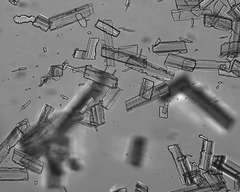Brushite
| Brushite | |
|---|---|
|
Possible Brushite crystals (not confirmed) found in bat guano in Jamaica | |
| General | |
| Category | Phosphate mineral |
| Formula (repeating unit) | CaHPO4·2H2O |
| Strunz classification | 8.CJ.50 |
| Crystal system | Monoclinic |
| Crystal class |
Domatic (m) H-M symbol: (m) |
| Space group | Aa |
| Unit cell |
a = 6.265 Å, b = 15.19 Å, c = 5.814 Å; β = 116.47°; Z = 4 |
| Identification | |
| Color | Colorless to pale or ivory-yellow |
| Crystal habit | Prismatic to tabular acicular crystals; typically powdery or earthy |
| Cleavage | Perfect on {010} and {001} |
| Tenacity | Brittle |
| Mohs scale hardness | 2.5 |
| Luster | Vitreous, pearly on cleavages |
| Diaphaneity | Transparent to translucent |
| Specific gravity | 2.328 |
| Optical properties | Biaxial (+) |
| Refractive index | nα = 1.539 - 1.540 nβ = 1.544 - 1.546 nγ = 1.551 - 1.552 |
| Birefringence | δ = 0.012 |
| 2V angle | Measured: 59 to 87° |
| Solubility | Readily in HCl |
| Other characteristics | Piezoelectric |
| References | [1][2][3][4] |
Brushite is a phosphate mineral with the chemical formula CaHPO4·2H2O. It forms colorless to pale yellow monoclinic prismatic crystals and as powdery or earthy masses.[2][4] It is the phosphate analogue of the arsenate pharmacolite and the sulfate gypsum.
Discovery and occurrence
Brushite was first described in 1865 for an occurrence on Aves Island, Nueva Esparta, Venezuela, and named for the American mineralogist George Jarvis Brush (1831–1912).[3] It is believed to be a precursor of apatite and is found in guano-rich caves, formed by the interaction of guano with calcite and clay at a low pH. It occurs in phosphorite deposits and forms encrustations on old bones. It may result from runoff of fields which have received heavy fertilizer applications.[3] Associated minerals include tanarakite, ardealite, hydroxylapatite, variscite and gypsum.[2]
Brushite is the original precipitating material in calcium phosphate kidney stones.
